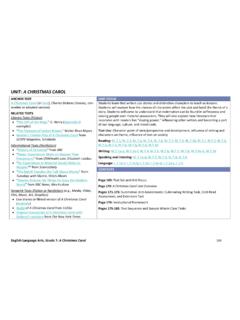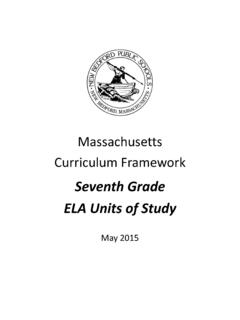Transcription of Eduqas English Literature GCSE Exemplar for: Component 2 ...
1 Eduqas English Literature GCSE Exemplar for: Component 2 ContentsA christmas CarolDr Jekyll and Mr Hyde 70 GCSE English Literature Specimen Assessment Materials 81 WJEC CBAC Ltd. SECTION B (19TH CENTURY PROSE) GENERIC ASSESSMENT OBJECTIVES GRID Questions 11-16 The following descriptions have been provided to indicate the way in which progression within the criteria is likely to occur. Each successive description assumes demonstration of achievements in lower bands. AO1, AO2 and AO3 are equally weighted in this question. Total marks 40 Band AO1:1a+b, AO1:2 AO2 AO3 5 33-40 marks Candidates: sustain focus on the task, including overview, convey ideas with consistent coherence and use an appropriate register; use a sensitive and evaluative approach to the task and analyse the extract and wider text critically; show a perceptive understanding of the extract and wider text, engaging fully, perhaps with some originality in their personal response; their responses include pertinent, direct references from across the extract and wider text, including quotations.
2 Candidates: analyse and appreciate writers use of language, form and structure; make assured reference to meanings and effects exploring and evaluating the way meaning and ideas are conveyed through language structure and form; use precise subject terminology in an appropriate context. Candidates: show an assured understanding of the relationships between texts and the contexts in which they were written, including, where relevant, those of period, location, social structures and literary contexts such as genre, and the contexts in which texts are engaged with by different audiences. 4 25-32 marks Candidates: sustain focus on the task, convey ideas with considerable coherence and use an appropriate register; use a thoughtful approach to the task; show a secure understanding of key aspects of the extract and wider text, with considerable engagement; support and justify their responses by well-chosen direct reference to the extract and wider text, including quotations.
3 Candidates: discuss and increasingly analyse writers use of language, form and structure; make thoughtful reference to the meanings and effects of stylistic features used by the writer; use apt subject terminology. Candidates: show a secure understanding of the relationships between texts and the contexts in which they were written, including, where relevant, those of period, location, social structures and literary contexts such as genre, and the contexts in which texts are engaged with by different audiences. 3 17-24 marks Candidates: focus on the task, convey ideas with general coherence and use a mostly appropriate register; use a straightforward approach to the task; show an understanding of key aspects of the extract and wider text, with engagement; support and justify their responses by appropriate direct reference to the extract and wider text, including quotations. Candidates: comment on and begin to analyse writers use of language, form and structure; make some reference to meanings and effects; use relevant subject terminology.
4 Candidates: show an understanding of the relationships between texts and the contexts in which they were written, including, where relevant, those of period, location, social structures and literary contexts such as genre, and the contexts in which texts are engaged with by different audiences. 2 9-16 marks Candidates: have some focus on the task, convey ideas with some coherence and sometimes use an appropriate register; use a limited approach to the task; show some understanding of key aspects of the extract and wider text, with some engagement; support and justify their responses by some direct reference to the extract and wider text, including some quotations. Candidates: recognise and make simple comments on writers use of language, form and structure; may make limited reference to meanings and effects; may use some relevant subject terminology. Candidates: show some understanding of the relationships between texts and the contexts in which they were written, including, where relevant, those of period, location, social structures and literary contexts such as genre, and the contexts in which texts are engaged with by different audiences.
5 1 1-8 marks Candidates: have limited focus on the task, convey ideas with occasional coherence and may sometimes use an appropriate register; use a simple approach to the task; show a basic understanding of some key aspects of the extract and wider text, with a little engagement; may support and justify their responses by some general reference to the extract and wider text, perhaps including some quotations. Candidates: may make generalised comments on writers use of language, form and structure; may make basic reference to meanings and effects; may use some subject terminology but not always accurately. Candidates: show limited understanding of the relationships between texts and the contexts in which they were written, including, where relevant, those of period, location, social structures and literary contexts such as genre, and the contexts in which texts are engaged with by different audiences. 0 marks Nothing worthy of credit. Nothing worthy of credit.
6 Nothing worthy of credit. Eduqas English Literature GCSE Exemplar for: Component 2 Section B A christmas Carol70 GCSE English Literature Specimen Assessment Materials 82 WJEC CBAC Ltd. SECTION B (19th CENTURY PROSE) INDICATIVE CONTENT christmas CarolYou should use the extract below and your knowledge of the whole novel to answer this question. Write about Scrooge and the way he changes throughout the your response you should: refer to the extract and the novel as a whole; show your understanding of characters and events in the novel; refer to the contexts of the novel.[40] This question assesses AO1, AO2 and AO3. Indicative content Responses may include: AO1 An overview of how Scrooge changes throughout the novel Comments on how he shuns other people as well as driving them away with the coldelements of his appearance and nature in the extract and the beginning of the novel Marley s initial visit The visitation of the ghosts The range of events witnessed by Scrooge during the visitations and how these lead him tochange The effect of other characters such as Tiny Tim, Belle, Fezziwig and Fred on ScroogeAO2 Comments on Dickens use of language in the extract and the novel Scrooge s initial description in the extract, imagery such as solitary as an oyster todemonstrate the closed nature of his character at this point The imagery of cold and wintry weather, for example, No wind that blew was bitterer than he and how this contrasts with how he is described later in the novel The hyperbolic nature of his initial description in the extract.
7 For example in the opening longlist of adjectives How Dickens initial description in the extract is contrasted with Scrooge as he appears laterand at the end of the novel, his role, as a second father to Tiny Tim, and as a goodfriend, as good a master, and as good a man as the good old city knew. AO3 Reference to the period in which the novel is set and its significance to the changing nature ofScrooge s character. For example, the importance of poverty and charity in nineteenthcentury London Scrooge s initial character and desire to be solitary as an avoidance of social responsibility,further highlighted by his comments such as, Are there no prisons, are there noworkhouses? His later despair at the appearance of Ignorance and Want at the end of Stave Three leadinghim to ask Have they no refuge or resource? Discussion of the nature of Scrooge s change and his eventual use of money for good toalleviate some problems of his contemporary world, perhaps in order to save himself too Comments on redemption and religious responsibilitiesThis is not a checklist.
8 Please reward valid B (19th Century Prose) Answer on one text only. A christmas Carol You are advised to spend about 45 minutes on this question. You should use the extract below and your knowledge of the whole novel to answer this question. Write about Scrooge and the way he changes throughout the your response you should: refer to the extract and the novel as a whole; show your understanding of characters and events in the novel; refer to the contexts of the novel.[40] Oh! but he was a tight-fisted hand at the grindstone, Scrooge! A squeezing, wrenching, grasping, scraping, clutching, covetous old sinner! Hard and sharp as flint, from which no steel had ever struck out generous fire; secret, and self-contained, and solitary as an oyster. The cold within him froze his old features, nipped his pointed nose, shrivelled his cheek, stiffened his gait; made his eyes red, his thin lips blue; and spoke out shrewdly in his grating voice. A frosty rime was on his head, and on his eyebrows, and his wiry chin.
9 He carried his own low temperature always about with him; he iced his office in the dog-days; and didn't thaw it one degree at christmas . External heat and cold had little influence on Scrooge. No warmth could warm, nor wintry weather chill him. No wind that blew was bitterer than he, no falling snow was more intent upon its purpose, no pelting rain less open to entreaty. Foul weather didn't know where to have him. The heaviest rain, and snow, and hail, and sleet, could boast of the advantage over him in only one respect. They often 'came down' handsomely, and Scrooge never did. Nobody ever stopped him in the street to say, with gladsome looks, 'My dear Scrooge, how are you? When will you come to see me? No beggars implored him to bestow a trifle, no children asked him what it was o'clock, no man or woman ever once in all his life inquired the way to such and such a place, of Scrooge. Even the blindmen's dogs appeared to know him; and when they saw him coming on, would tug their owners into doorways and up courts; and then would wag their tails as though they said, 'no eye at all is better than an evil eye, dark master!
10 ' But what did Scrooge care? It was the very thing he liked. To edge his way along the crowded paths of life, warning all human sympathy to keep its distance, was what the knowing ones call 'nuts' to Scrooge. 7172 This response is strongest on AO1. There are simple comments on the language and some understanding of the contexts. Overall it would receive a mark just into Band is a sound response. It achieves Band 4 for all of the the AOs although it is strongest on AO1. Overall it would receive a mark in the middle of Band are only implicit references to AO3 (context) and AO2 (style) here, however these are rooted in some understanding of the novel. Overall this response would get a mark in mid Band 2. 777879 This is a purposeful and assured answer with a clear sense of overview and evaluation throughout. It would receive a mark just into the bottom of Band 5. Closer reference to AO2 would make this a more secure Band 5 response. 80 Eduqas English Literature GCSE Exemplar for: Component 2 Section B The Strange Case of Dr Jekyll and Mr Hyde 81 GCSE English Literature Specimen Assessment Materials 87 WJEC CBAC Ltd.



